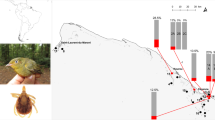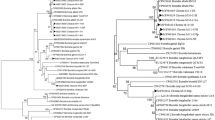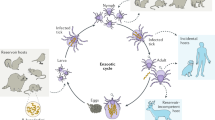Abstract
THE Lyme disease spirochaete, Borrelia burgdorferi s.l. , is the only Borrelia known to infect both mammals and birds1. The main vertebrate reservoirs of B. burgdorferi are thought to be various small and intermediate size mammals2, but the importance of birds as a reservoir has not been thoroughly explored. In the Northern and Southern Hemispheres the seabird tick, Ixodes uriae, is prevalent and closely associated with many species of colony-nesting marine birds3. Here we report the presence of spirochaetes, demonstrated by immunofluorescent assay, by polymerase chain reaction and in culture, in I. uriae infesting razorbills on an island in the Baltic Sea. This island is free from mammals. The protein profile of the spirochaetes and the sequences of their flagellin and ospA genes are identical to those of the Lyme disease spirochaete, Borrelia burgdorferi s.l. , previously isolated from I. ricinus on a nearby island. In biopsies from the foot web of razorbills, B. burgdorferi-specific DNA was detected after amplification by polymerase chain reaction. Our results suggest that birds play an important part in the maintenance of B. burgdorferi and that mammals may not be a prerequisite for its life cycle.
This is a preview of subscription content, access via your institution
Access options
Subscribe to this journal
Receive 51 print issues and online access
$199.00 per year
only $3.90 per issue
Buy this article
- Purchase on Springer Link
- Instant access to full article PDF
Prices may be subject to local taxes which are calculated during checkout
Similar content being viewed by others
References
Anderson, J. F., Johnson, R. C., Magnarelli, L. A., & Hyde, F. W. Infect. Immun. 51, 394–396 (1986).
Anderson, J. F. Rev Infect. Dis. 11 (suppl. 6), 1451–1458 (1989).
Clifford, C. M. in Arctic and Tropical Arboviruses (ed. Kurstak, E.) 83–100 (Academic, New York, 1979).
Olsén, B. & Grenmyr, V. Vår Fågelvärd 3, 11–14 (1992).
Pokki, J. Acta zool. Fenn. 164, 13–17 (1981).
Southwood, T. R. E. in Ecological Methods with Particular Reference to the Study of Insect Populations 170–201 (Chapman and Hall, New York, 1978).
Filippova, N. A. Ixodid Ticks Subfamily Ixodinae Fauna SSSR (Nov. Ser. no 114, Paukoobraznye 4, Nauka, Moscow, 1977).
Barbour, A. G., Hayes, S. F., Heiland, R. A., Schrumpf, M. E. & Tessier, S. L. Infect. Immun. 52, 549–554 (1986).
Gassman, G. S., Kramer, M., Göbel, U. B. & Wallich, R. Nucleic Acids Res. 17, 3590 (1989).
Bergström, s., Bundoc, V. G. & Barbour, A. G. Molec. Microbiol. 3, 479–486 (1989).
Barbour, A. G. Yale J. biol. Med. 57, 521–525 (1984).
Picken, R. J. clin. Microbiol. 30, 99–114 (1992).
Bergström, S. et al. Scand. J. Infect. Dis. 24, 181–188 (1992).
Barbour, A. G., Tessier, S. L. & Todd, W. J. Infect. Immun. 41, 795–804 (1983).
Kolonin, G. V. World Distribution of Ixodid Ticks (Genus Ixodes) (Nauka, Moscow, 1981).
Sanger, F., Nicklen, S. & Coulson, A. R. Proc. natn. Acad. Sci. U.S.A. 74, 5463–5467 (1979).
Author information
Authors and Affiliations
Rights and permissions
About this article
Cite this article
Olsén, B., Jaenson, T., Noppa, L. et al. A Lyme borreliosis cycle in seabirds and Ixodes uriae ticks. Nature 362, 340–342 (1993). https://doi.org/10.1038/362340a0
Received:
Accepted:
Published:
Issue Date:
DOI: https://doi.org/10.1038/362340a0
This article is cited by
-
Spatial and temporal aggregation of albatross chick mortality events in the Falklands suggests a role for an unidentified infectious disease
Polar Biology (2021)
-
Tick infestations correlates at a Falkland Islands Black-browed Albatross colony
Polar Biology (2019)
-
Recurrent evolution of host and vector association in bacteria of the Borrelia burgdorferi sensu lato species complex
BMC Genomics (2016)
-
Novel relapsing fever Borrelia detected in African penguins (Spheniscus demersus) admitted to two rehabilitation centers in South Africa
Parasitology Research (2012)
-
Seabird ticks (Ixodes uriae) distribution along the Antarctic Peninsula
Polar Biology (2011)
Comments
By submitting a comment you agree to abide by our Terms and Community Guidelines. If you find something abusive or that does not comply with our terms or guidelines please flag it as inappropriate.



